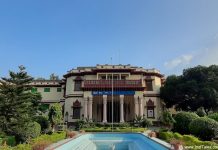If you have been to Mumbai or if you live in the megapolis, you have used the CST Mumbai station. Maybe you have just passed by this beautiful station. Let me walk you through the history & quirky facts about this heritage railway station. A lot has been written about this lovely train terminus, so let me just give you some quirky facts and trivia about it. This includes the small nuances that you should not miss when you visit CST the next time.

CST Mumbai or Chhatrapati Shivaji Terminus
Chhatrapati Shivaji Terminus Railway Station is India’s oldest and most beautiful railway station. Originally called Victoria Terminus or simply VT, UNESCO inscribed it as a World Heritage Site in 2004.

CST Railway Station stands where the story of Indian Railways began in 1853 when the first ever train chugged out of Bori Bunder station. It took 10 years to build this lovely station between 1878-88.
Do you know CST Mumbai is one of the two UNESCO World Heritage Sites that are still in active service?
The other one also belongs to the railways – Mountain Railways of India including the Darjeeling Himalayan Rail.
The CST Mumbai Museum

Walk through the main gates of the Railway Station building. You can easily spot it with the two giant lions that guard this gate. To the right of this gate is the single-hall museum that aims to show you the history of Indian Railways when it was called the Great Indian Peninsula Railway.

The journey of Railways in Mumbai is traced through maps which are lovely – you not only see the growth of the rail network but also that of the city. It looks like they were growing hand in hand.

I loved the display of the architectural design sheets placed next to the actual building photographs. You can see how intricately the design was done on the drawing table. It almost feels the actual building was made as a 3-D image of the drawing. I quietly uttered a word of appreciation to architect F W Stevens. The next minute, I spotted an interesting communication between Stevens and the Railway department, where he demands an additional compensation of Rs 5000/ – Remember this was still 1888.

You see the various communications exchanged, the drawings, the logos, and even the good old silver cutlery.
Ferroequinology – Name for the study of railways

Timetable
A look at the timetable would make you appreciate the one who designed it – giving you all the information in one square box. It has train timings, fares, distances, and all the stations.

If you thought the people of India took to trains without any persuasion, look at this advertisement for Deccan Queen – that still runs between Mumbai & Pune. Even the timetable was published on the front page of The Bombay Times. It is said that regular travelers on this train could even get their mail delivered on the Deccan Queen.
You can see the model of Sahib – one of three engines that pulled the first-ever train in India. The other two are called Sindh & Sultan.

GIPR had 10 directors initially and two of them were Indians – Jagannath Nana Shanker Shett and Cursetjee Jamsetjee Jeejeebhoy.

The commemorative postage stamps issued on railways are on display. How I wish people could buy these stamps, maybe even their replicas.
Story of the First Indian Train between Bori Bunder and Thane

It is said that 400 invited guests traveled on the first train that traveled between Bori Bunder as the CST area was then known and Thane some 35 km away on April 16, 1853.
21 gun salute was given to the train before its 14 carriages were pulled by the 3 engines – Sahib, Sindh & Sultan
High tea was arranged for everyone on board at Thane where special arrangements were made to receive the guest on board this historic ride. One can only imagine the importance of the people chosen for this special train.
Since there was a paucity of space, the ticketing office of GIPR operated from Shankar Shett’s home for some time.
The Star Chamber

When I first heard the word star chamber, I expected it to be a star-shaped chamber. I would have fooled myself had I shared it with anyone else. The chamber is actually where the ticket-issuing office is. If you have ever taken a train from CST Mumbai, you would have seen this chamber. However, to see the stars you have to stretch your neck and look at the ceiling. These are stars made of gold sparkling on the pistachio-green ceiling. The view of the arched room looks beautiful from the first floor.
Arches create an aura of it being a large durbar hall.
Do people buying tickets look up and admire or are they too busy?
In & Around the Iconic Dome of CST Mumbai

The dome stands tall at the center of the building. Come with me inside it, get up close & personal with this architectural masterpiece.

The doors leading to the staircase that takes you closer to the dome are a piece of beauty. Framed by a set of recessed arches, its wood shines as if it has just been polished. The brass fittings add a regal aura and you know you are entering a special space.

As you enter you see a lion with a coat of arms welcoming you with its towering presence.
Spiral Staircase
As soon as I took my eyes off the lion, they were beheld by the spiral staircase that goes closer to the dome. There is no support for this wide staircase except for the support that comes from the thick walls. The walls are good 8-10 feet thick. The sculpted wall behind the staircase frames it in a way that your eyes struggle to decide which is the most beautiful part of the visual.

There is fine Jaali work between the two levels.
On the first floor, you can step out and take a look at the upper stories of the building.

To reach the dome you have to take the narrow metal stairs, followed by another narrow staircase with almost nothing to hold. The stained glass that you see when you reach the top is worth all the effort.

The double layer of stained glasses tells the story of GIPR and highlights the journey from elephant rides to train coaches. When you stand right next to the dome you realize how big it is.

The view of the rest of the heritage building including the central railway office in the building behind this is lovely. The height changes the perspectives of the buildings surrounding the railway station.
CST Railway Station from the outside

The outer structure of Chhatrapati Shivaji Terminus is majestic and imposing.
Notice some of these nuances:
The arches at 3 different levels represent 3 different architectural styles representing 3 different eras.
There is a bust of each of the 10 directors of GIPR or Great India Peninsular Railway.

The empty slot in the middle held a statue of Queen Victoria after whom the terminal was initially named. After independence, the statue was removed.
Gargoyles are the water management system of the heritage building. See the various animals that form the gargoyles all around the facade.

The most intriguing bit for me was the base of the windows with 16 different types of turbans carved as bas-reliefs. I can only guess that this was to represent the diversity of the native population.

The toilets in the corner look like a chamber, it is only when the guide points to the pipe running along that you figure out that it is a toilet.

Indian Flora and Fauna
The Railway Station is full of Indian flora and fauna. You can walk through the sculpted pillars and get a lesson about local biodiversity. My favorite though is this dancing peacock carved on one of the windows.

The lady on top looks small but she is good 16+ ft tall and is called – The Lady of Progress. She holds the wheel in her left hand symbolizing progress or movement towards progress. In her right hand, she holds the torch, much like the Statue of Liberty. Our Guide told us that this symbolizes the fact that the city never sleeps. Well, it seems it is in the DNA of Mumbai that it could never sleep.
Travel Tips for CST Mumbai

- You can take a guided tour of the Railway station that covers its heritage parts as well as the Railway Museum.
- The museum is open from 2 PM – 5 PM on weekdays. I wonder why they do not open on weekends as that is when the maximum number of visitors would come. Hope this changes soon.
- The heritage tour takes about an hour. The dome part that I mentioned above is not a part of the tour, the rest of everything is.
- At the time of writing, the tour ticket is priced at INR 200 with a special rate of INR 100 for students.
Recommend you read the following attractions for visitors of the Megapolis.
Dr. Bhau Daji Lad Museum – Celebrating the city of Mumbai
Banganga Tank – the Ancient heritage
Exploring the Street Art in Bandra














Thank you for sharing this. CST is one of my favourite buildings in Bombay, and I loved getting to revisit it through your lens. I would love to take part in a heritage tour on my next visit to the city and explore a few more of CST’s nooks and crannies. Great post!
Thanks, Veena. Glad that you enjoyed the post. You must take the heritage tour of CST. You would see the corners that are otherwise inaccessible and the museum in full trivia.
Wow.. never got to know the inside story of this such beautiful building. Visited it during Diwali.. It glows up with all colored lights. Great sight.
Well Harish, next time you are in Mumbai, you know what to explore.
Mm, my favorite structure in the world! Thanks for the detailed post and beautiful photos. I’ve been to this museum.
It is a lovely building, Antonina. It is also an important structure because story of Indian railway began here and it is probably one of the busiest railway stations in the world.
I wanted to have the tour for the CST Building. I did ask at the railway station counters, but they had no responses. From your write-up I realised why I missed it. Next time, a trip to see only the CST insides. It is a beautiful building. Every time I go there, I pause and look at all its beauties.
Lata, I guess all railway officials at CST should know this. I will share this feedback with them. I am sure many more people are missing out because of lack of information.
Enjoy the trip !
I live in chennai .After reading this blog i am thinking to visit Chattrapathi Shivaji Terminus atleast once in my life time.At first , I thought it was just an railway station and I don’t know it is an heritage center in mumbai
Glad you are inspired to travel to CST Mumbai…
How true is the story of the designs of Melbourne train station and Mumbai station getting interchanged? The CST design was originally meant for the Melbourne Train Station.
Mukul, I have not heard of this. I will try and find more about it.
thank you,
this was a very well written article and i had no knowledge about most of these things
i appreciate it very much
Thanks, Rupali. Glad you discovered some new facets of CST Mumbai.
I remember walking by the foot of this building and being enamored even when my blogging journey didn’t start. Then I revisited with my DSLR and clicked at my heart’s content. Loved this blog that took an inside peak too.
Next time you must step in and see the nuances of CST, both you and your camera would love it.
Oh wow, such a wonderful blog. I love it this gives information about Mumbai